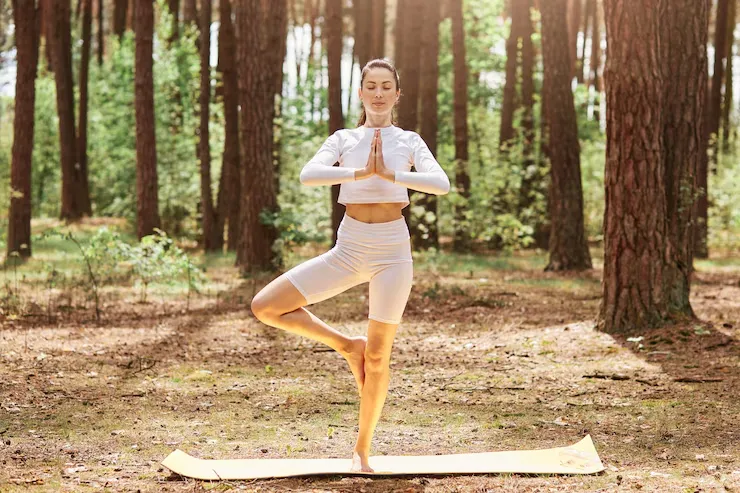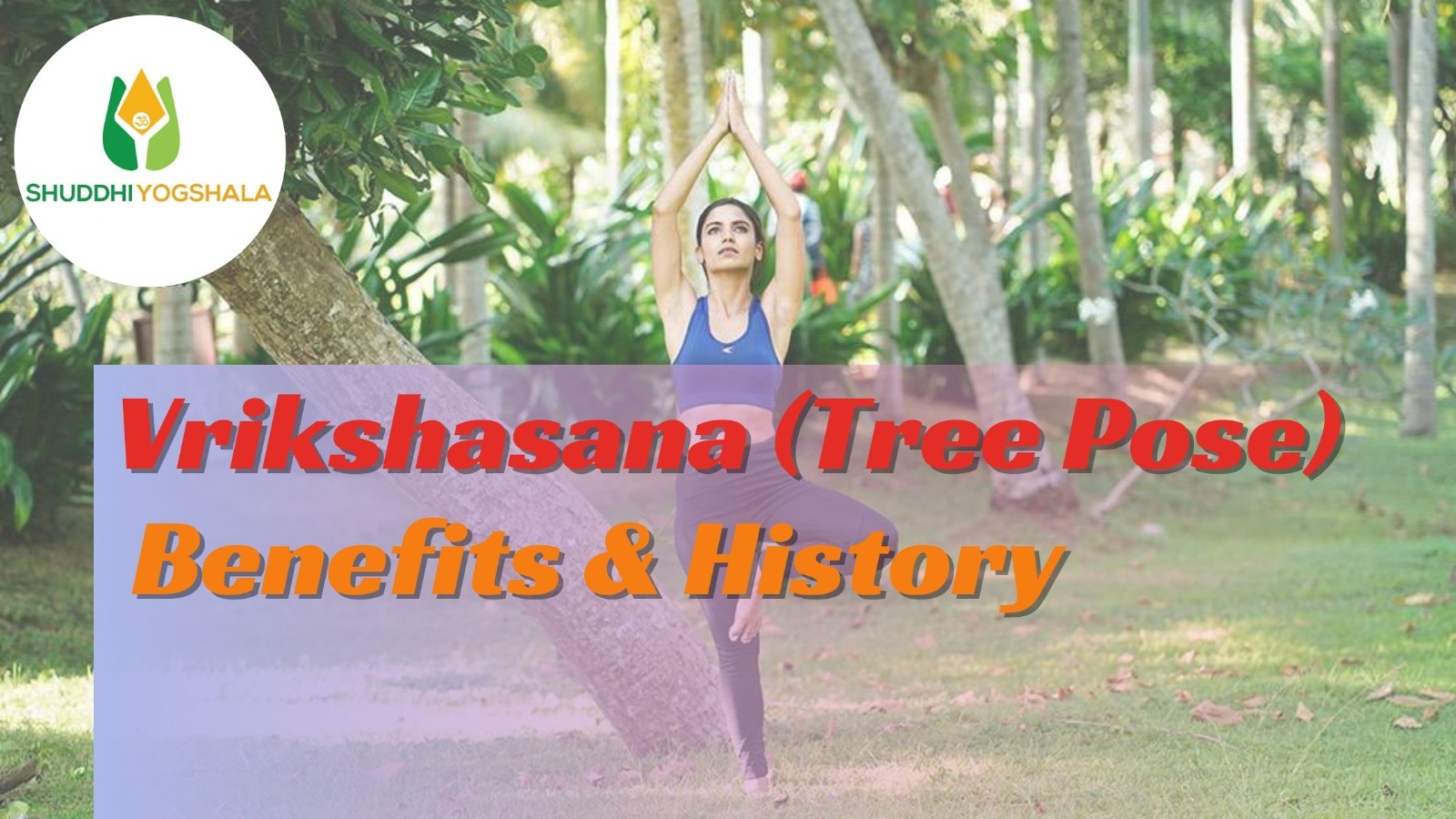vrksasana tree pose
Vrikshasana, or the Tree Pose, is a prominent standing and balancing posture in Hatha Yoga. The term “Vrikshasana” originates from the Sanskrit word “vriksha,” meaning “tree,” and the pose embodies the stability and grace of a tree, symbolizing balance and poise. This asana is celebrated for its ability to enhance physical balance, stability, and concentration.
How to Perform Vrikshasana (Tree Pose)
1. Begin by standing straight with your feet together.
2. Bend your right leg at the knee and place your heel against the root of your left thigh. Ensure that your right sole is pressed firmly and flat against your left thigh, with pointing downward.
3.Distribute your body weight evenly across your left foot, balancing on the ball, heel, and edges of the foot.
4. Straighten your arms and raise them overhead, bringing your palms together in a Namaste posture.
5. Fix your gaze straight ahead on a single point, and take deep breaths to facilitate the flow of Prana (life force energy) throughout your body.
6. Hold the position for 30 to 60 seconds, or as long as comfortable.
7. Slowly separate your palms, lower your arms, and release the right leg, exhaling as you return to the standing position.
Benefits of Vrikshasana (Tree Pose):
1.Improved Balance:
Enhances stability by requiring you to stand on one leg, crucial for overall physical well-being.
2.Better Posture:
Aligns the spine and shoulders, promoting a healthier posture, especially for those who sit for extended periods.
3.Increased Awareness:
Cultivates mindfulness and body awareness, helping you become more conscious of your alignment.
4. Leg Muscle Toning: Strengthens and tones the muscles of the legs, offering a comprehensive workout for the lower body.
5. Improved Concentration: Enhances mental clarity and focus, making it a powerful exercise for both the body and mind.
6. Prevention of Sciatica: Alleviates or prevents sciatica by stretching and strengthening the lower back and legs.
7. Stimulates the Root Chakra: Activates the Mooldhara Chakra, enhancing the flow of prana and grounding energy.
Precautions:
1. Breathing: Maintain steady, controlled breathing to assist with concentration and balance.
2. Core Engagement: Activate your abdominal muscles to support your posture.
3. Balance: If you struggle with balance, start near a wall or use a chair for support until you gain confidence.
4. Foot Placement: Begin by placing your foot lower on your leg, perhaps with the toes touching the ground for additional support, before moving it higher.
5. Gaze: Focus on a stable point in front of you to help maintain balance.
Contraindications:
1. Avoid it if you have recent injuries to the leg, knee, or back.
2. Those with migraines, insomnia, high or low blood pressure, or arthritis in the knees or hips should consult a healthcare professional before attempting this pose.
How Vrikshasana Helps Prevent Diseases:
Vrikshasana contributes to overall health by improving circulation, particularly in the legs, which can help prevent varicose veins and peripheral artery disease. The pose also supports cardiovascular health, reducing the risk of heart disease. By promoting relaxation and reducing stress levels, Vrikshasana can indirectly help prevent conditions like hypertension, heart disease, and mental health disorders. Good posture, encouraged by this pose, can prevent musculoskeletal issues like chronic back and neck pain. Additionally, the mental clarity and relaxation achieved through this asana may help improve overall mental health and combat insomnia.
Common Mistakes to Avoid:
1. Incorrect Form: Stretching with improper form can lead to injuries such as ligament strains or joint issues. Always prioritize alignment and technique.
2. Difficulty Maintaining the Pose: Beginners may find it challenging to maintain balance. Use the support of a wall or chair and position your foot lower on the thigh if needed.
3. Hand Position: If raising your hands above your head feels difficult, start by folding them in front of your chest and gradually progress as you gain confidence.
4. Who Should Avoid Vrikshasana:
While Vrikshasana offers numerous benefits, it may not be suitable for everyone. Individuals with high blood pressure, migraines, insomnia, headaches, or injuries to the legs, arms, or back should either avoid this pose or consult with a healthcare professional or qualified yoga instructor before attempting it.
Preparatory Poses for Tree Pose (Vrksasana) in a Yoga Sequence
Tree Pose (Vrksasana) is a foundational balancing standing yoga pose that requires both practice and the mastery of simpler, preparatory poses. Below are key preparatory poses that help build the strength, flexibility, and balance needed for Vrksasana:
Urdhva Hastasana (Palm Tree Pose):
Begin by standing with your feet together.
Raise your body onto your toes while stretching your arms above your head, clasping your fingers.
Hold this position as long as you’re comfortable.
This pose serves as an initial step in practicing balance, helping you stabilize your body.
Standing Yoga Seal Pose (Dandayamana Yoga Mudra):
Stand straight and stretch your arms behind you, clasping your fingers together.
Expand your upper body and lean forward, bringing your forehead close to your knees.
This stretch targets the shoulders and arms, preparing them for the balance required in Vrksasana.
Upward Salute Side Bend Pose (Parsva Urdhva Hastasana):
Stand straight and raise your arms above your head, bringing your palms together in Namaste.
Bend your upper body sideways from the hips while maintaining a straight gaze forward.
This pose stretches the shoulders, back, and sides of the body, helping to tone the muscles around the hips and burn excess fat.
These preparatory poses build the necessary foundation for balancing in Tree Pose, enhancing your overall stability and strength.
History of the Tree Pose (Vrksasana)
Vrksasana, or the Tree Pose, is revered for its ability to channel energy from the Root Chakra to the Crown Chakra. Of the 8.4 million asanas taught by Lord Shiva, 32 are highlighted in the Gheranda Samhita, with Vrksasana being one of the most significant. The pose is described in Chapter 2, Verse 36 of the Gheranda Samhita: “Place the right foot at the top of the thigh and stand on the ground like a tree. This is called Vrksasana.”
Ancient sculptures in various Indian temples depict yogins with long matted hair standing in Vrksasana, symbolizing their deep penance and meditation. One such legend tells of King Bhagiratha, who stood in the Tree Pose for many years to persuade Lord Brahma and Lord Shiva to bring the Ganges River to Earth. Additionally, these sculptures show yogins balancing on one leg near a tree, further emphasizing the spiritual significance of this pose.
Beyond Hinduism, trees hold sacred significance in Jainism and Buddhism as well. Buddhists revere the Peepal Tree, under which Gautama Buddha attained enlightenment. In Jainism, each of the 24 Tirthankaras (Jinas) is associated with a specific tree, highlighting the spiritual connection between trees and yogic practices across these traditions.
At Shuddhi Yogshala, we offer a holistic approach to wellness, including Yoga Asanas designed to improve digestive health. Whether you’re interested in a Yoga Teacher Training, Online Yoga classes, or finding a serene Yoga Studio to practice in, we have options to suit your needs. Join our Online Yoga Teacher Training Class to deepen your practice and share the benefits of yoga with others. Transform your life with yoga at Shuddhi Yogshala!
vrksasana tree pose
The vrksasana tree pose, also known as Tree Pose in Hatha Yoga, is a well-known standing and balancing posture. The name comes from the Sanskrit word “vriksha,” meaning “tree,” and this pose reflects the strength, grace, and stability of a tree. Practicing vrksasana tree pose helps improve physical balance, enhance stability, and boost concentration, making it a powerful asana for both the body and mind.
How to Perform Vrikshasana (Tree Pose)
-
Start the vrksasana tree pose by standing tall with your feet together and arms relaxed by your sides.
-
Gently bend your right knee and place your right heel at the root of your left thigh. Make sure your right foot’s sole is flat and firmly pressing against your inner thigh, toes pointing downward.
-
Balance your body weight evenly across your left foot—distribute it over the ball, heel, and edges for better stability.
-
Slowly extend your arms upward and join your palms together above your head in a Namaste position.
-
Keep your gaze focused on a fixed point straight ahead. Take slow, deep breaths to enhance concentration and allow the Prana (life energy) to flow freely.
-
Hold the vrksasana tree pose for 30 to 60 seconds, or as long as it feels comfortable.
-
To release the pose, gently lower your hands, separate your palms, and bring your right leg down while exhaling. Return to the standing position mindfully.
Benefits of Vrikshasana (Tree Pose)
-
Improved Balance: Practicing vrksasana tree pose regularly helps enhance your balance and stability by challenging you to stand on one leg, which supports overall physical well-being.
-
Better Posture: This pose encourages proper alignment of the spine and shoulders, promoting a healthier posture—especially beneficial for people who spend long hours sitting.
-
Increased Awareness: Vrksasana tree pose cultivates mindfulness and heightens body awareness, helping you stay conscious of your alignment and movement.
-
Leg Muscle Toning: By engaging the lower body, the vrksasana tree pose strengthens and tones leg muscles, offering a complete workout for your thighs, calves, and ankles.
-
Improved Concentration: Holding the pose with focused breathing enhances mental clarity and concentration, making it a great practice for both body and mind.
-
Sciatica Relief and Prevention: This yoga posture can help alleviate and prevent sciatica by gently stretching and strengthening the lower back and legs.
-
Root Chakra Activation: Vrksasana tree pose stimulates the Mooladhara (Root) Chakra, supporting the flow of prana (life energy) and promoting a sense of grounding and stability.

Precautions:
-
Breathing: In vrksasana tree pose, steady and mindful breathing is key. It helps improve your focus and supports balance while holding the posture.
-
Core Engagement: Gently engage your core muscles to support your spine and enhance stability while holding the vrksasana tree pose.
-
Balance Support: If you’re new to the vrksasana tree pose or struggling with balance, practice near a wall or use a chair for extra support until you’re more confident.
-
Foot Placement: Start by placing your foot lower on the standing leg, possibly with toes touching the floor, and gradually work your way up as your balance improves.
-
Gaze (Drishti): Fix your eyes on a still point in front of you to help maintain focus and steadiness in the vrksasana tree pose.
Contraindications:
-
Avoid practicing vrksasana tree pose if you have any recent injuries to your leg, knee, or back, as it may put pressure on these areas.
-
Individuals with conditions like migraines, insomnia, high or low blood pressure, or arthritis in the knees or hips should consult a healthcare professional before attempting the vrksasana tree pose.
How Vrikshasana Helps Prevent Diseases:
Vrikshasana contributes to overall health by improving circulation, particularly in the legs, which can help prevent varicose veins and peripheral artery disease. The pose also supports cardiovascular health, reducing the risk of heart disease. By promoting relaxation and reducing stress levels, Vrikshasana can indirectly help prevent conditions like hypertension, heart disease, and mental health disorders. Good posture, encouraged by this pose, can prevent musculoskeletal issues like chronic back and neck pain. Additionally, the mental clarity and relaxation achieved through this asana may help improve overall mental health and combat insomnia.
Common Mistakes to Avoid:
1. Incorrect Form: Stretching with improper form can lead to injuries such as ligament strains or joint issues. Always prioritize alignment and technique.
2. Difficulty Maintaining the Pose: Beginners may find it challenging to maintain balance. Use the support of a wall or chair and position your foot lower on the thigh if needed.
3. Hand Position: If raising your hands above your head feels difficult, start by folding them in front of your chest and gradually progress as you gain confidence.
4. Who Should Avoid Vrikshasana:
While Vrikshasana offers numerous benefits, it may not be suitable for everyone. Individuals with high blood pressure, migraines, insomnia, headaches, or injuries to the legs, arms, or back should either avoid this pose or consult with a healthcare professional or qualified yoga instructor before attempting it.
Preparatory Poses for Tree Pose (Vrksasana) in a Yoga Sequence
Tree Pose (Vrksasana) is a foundational balancing standing yoga pose that requires both practice and the mastery of simpler, preparatory poses. Below are key preparatory poses that help build the strength, flexibility, and balance needed for Vrksasana:
Urdhva Hastasana (Palm Tree Pose):
Begin by standing with your feet together.
Raise your body onto your toes while stretching your arms above your head, clasping your fingers.
Hold this position as long as you’re comfortable.
This pose serves as an initial step in practicing balance, helping you stabilize your body.
Standing Yoga Seal Pose (Dandayamana Yoga Mudra):
Stand straight and stretch your arms behind you, clasping your fingers together.
Expand your upper body and lean forward, bringing your forehead close to your knees.
This stretch targets the shoulders and arms, preparing them for the balance required in Vrksasana.
History of the Tree Pose (Vrksasana)
Vrksasana, or the Tree Pose, is revered for its ability to channel energy from the Root Chakra to the Crown Chakra. Of the 8.4 million asanas taught by Lord Shiva, 32 are highlighted in the Gheranda Samhita, with Vrksasana being one of the most significant. The pose is described in Chapter 2, Verse 36 of the Gheranda Samhita: “Place the right foot at the top of the thigh and stand on the ground like a tree. This is called Vrksasana.”
Ancient sculptures in various Indian temples depict yogins with long matted hair standing in Vrksasana, symbolizing their deep penance and meditation. One such legend tells of King Bhagiratha, who stood in the Tree Pose for many years to persuade Lord Brahma and Lord Shiva to bring the Ganges River to Earth. Additionally, these sculptures show yogins balancing on one leg near a tree, further emphasizing the spiritual significance of this pose.
Beyond Hinduism, trees hold sacred significance in Jainism and Buddhism as well. Buddhists revere the Peepal Tree, under which Gautama Buddha attained enlightenment. In Jainism, each of the 24 Tirthankaras (Jinas) is associated with a specific tree, highlighting the spiritual connection between trees and yogic practices across these traditions.
At Shuddhi Yogshala, we offer a holistic approach to wellness, including Yoga Asanas designed to improve digestive health. Whether you’re interested in a Yoga Teacher Training, Online Yoga classes, or finding a serene Yoga Studio to practice in, we have options to suit your needs. Join our Online Yoga Teacher Training Class to deepen your practice and share the benefits of yoga with others. Transform your life with yoga at Shuddhi Yogshala!





